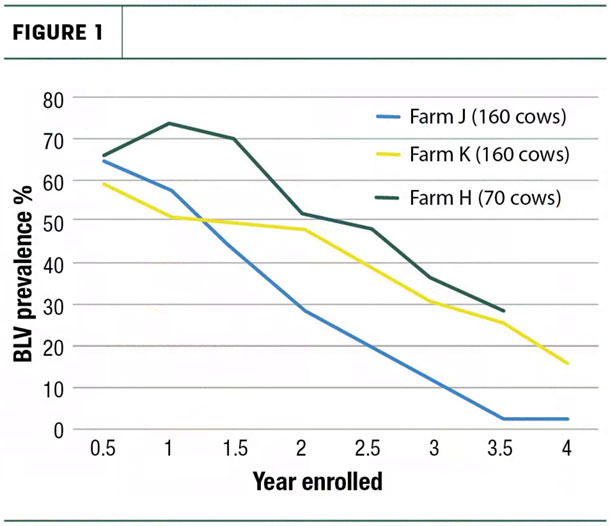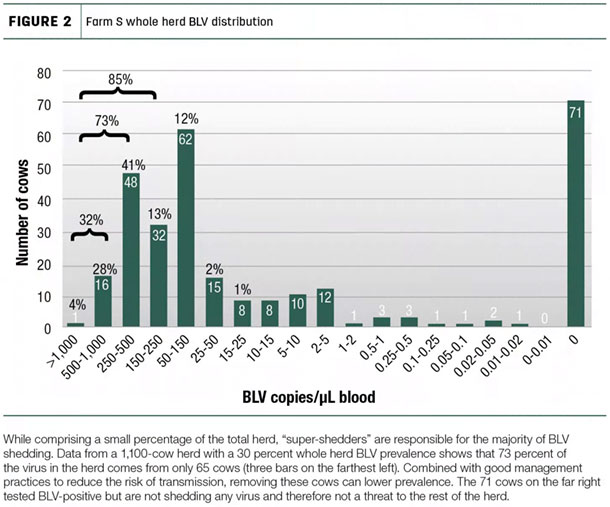Bovine leukosis, caused by bovine leukemia virus (BLV), is an infectious disease that can wreak havoc on your herd and the dairy industry, and it is more common than you think.
The USDA estimates that BLV has infected 89% of all dairy herds in the United States, with approximately 45% of total cows infected. BLV has been disregarded for years and likewise, the heavy selective pressure for milk production over health traits has likely made today’s dairy cows more susceptible to BLV infection. As such, prevalence has dramatically increased from 10% in the 1960s to today’s rate.

While most animals show no outward signs or symptoms of BLV, cows with advanced disease can develop lymphoma that leads to death or condemnation at slaughter. Even before it gets to that stage, BLV is affecting your herd’s performance and profitability.
Effects on production and longevity
A Michigan State University (MSU) research group, in collaboration with our cooperative, set out to investigate what effect, if any, BLV infection had on milk production, culling and longevity in cows. In several studies, we determined that BLV-positive cows with a higher enzyme-linked immune sorbent assay (ELISA) value had lower predicted 305-day mature equivalent milk yields and that higher herd prevalence was strongly associated with a lower 12-month rolling herd average.
We also found that herds with a higher BLV prevalence were less likely to have third-lactation-or-greater cows on farm, and that positive cows with a higher BLV ELISA value were less likely to stay in the herd, implying that the infection affects cow longevity. Despite these effects, in a survey sent to 113 Michigan dairy herds, ranging in size from 120 to 6,700 cows, it was determined that most herd managers and owners did not consider BLV a significant issue.
Effects on cow immune function
We have known for some time that BLV affects the way a cow’s immune system works and in turn, likely affects her ability to fight off other infections. When cows are infected with BLV, the proportions of the different types of white blood cells, all with specific roles to play, change. BLV-positive cows also respond differently than their negative herdmates when vaccinated with certain vaccines or routine boosters, implying that infected cows are not as protected against diseases for which they are immunized. Additionally, when cows were infected with a new antigen that they had never encountered before, BLV-infected cows mounted abnormal immune responses.
Super-shedders and reducing prevalence
In order to study BLV or identify positive cows, we need an effective diagnostic test. The widely used milk ELISA test, while extremely accurate, could not differentiate between which cows were shedding the most virus and therefore, most contagious to their herdmates. Using a blood-based PCR (polymerase chain reaction) test that can detect the DNA of the virus itself, it was discovered that some cows were carrying an exponentially higher number of viruses (called proviral load) in their blood than even other BLV-positive cows; they are called “super-shedders.” Early BLV PCR tests that determined proviral load were expensive, very laborious and only available through research collaboration.
Because of this, our researchers have developed a faster, more cost-effective, and commercially available blood PCR DNA test to determine which cows in a herd may be super-shedders – the BLV Super-Shedders (SS1) PCR assay. Using this PCR test, three pilot herds were screened twice a year to identify the cows with the highest number of viruses and to remove those animals from the herd. This strategy proved to be effective in significantly reducing overall herd prevalence. These herds that have been successful in lowering their BLV prevalence also no longer have super-shedders. The initial trial was expanded to include more and larger herds; this field trial is currently on-going.

Previous research led us to believe that BLV was mainly a problem in older cows. While it’s true that the within-lactation prevalence is generally higher as cows get older, we began to observe the occurrence of super-shedders even in fresh heifers. Therefore, our research group will use our SS1 test to further investigate infection dynamics in youngstock from birth through breeding and entering the milking herd.
It has long been hypothesized that BLV susceptibility, like that of many other diseases, has a genetic component. Researchers have identified several genetic markers of susceptibility or resistance to BLV infection and disease progression. In addition to being able to identify the super-shedders, our SS1 assay has been able to identify cows that consistently do not shed any virus despite being BLV-positive by ELISA testing. We are hopeful that these markers will become part of a selection index to breed for cows with increased genetic immune potential and resistance to BLV.
Taking action against BLV can improve overall herd health and profitability. Bovine leukosis is a complicated disease, and eradication is a challenge. However, researchers at our cooperative and MSU are working diligently to understand the mechanisms behind the disease as well as help producers manage it in their own herds. ![]()

-
Kelly Sporer
- Research Scientist/Diagnostic Technical Specialist
- CentralStar Cooperative Inc.
- Email Kelly Sporer






